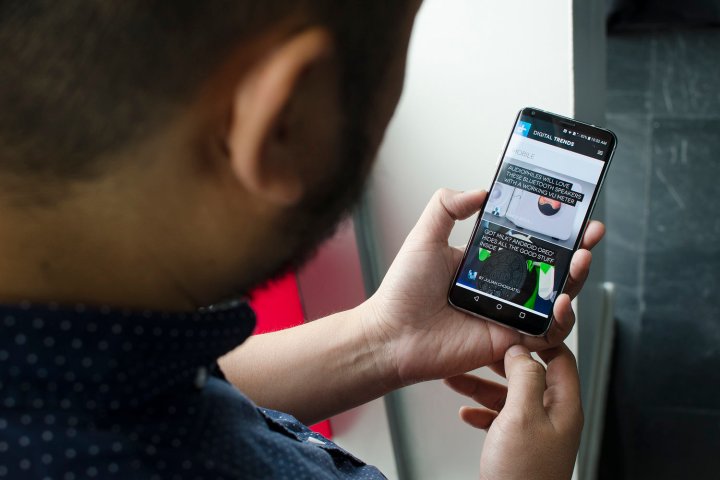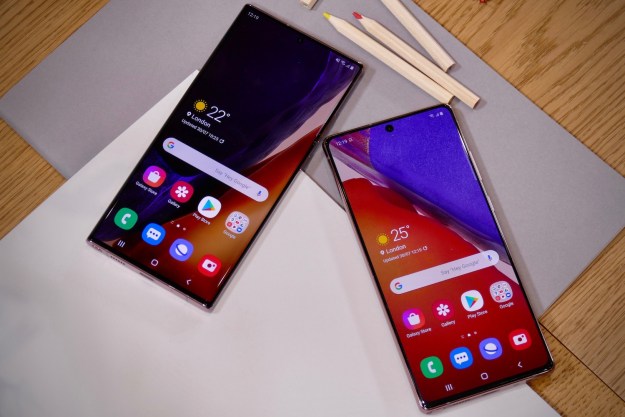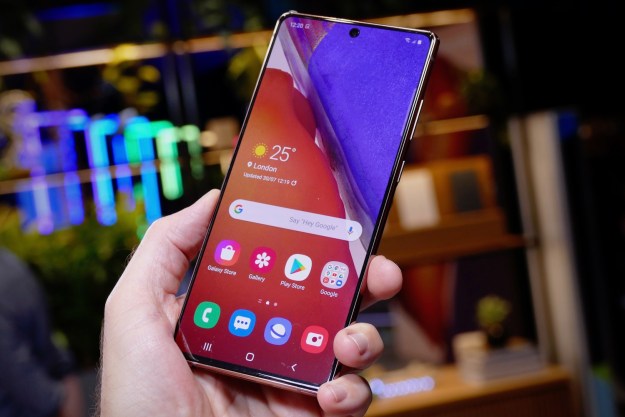
But there’s never been a tougher playing field. The V30 not only has to contend with stalwarts like the iPhone 7 and Galaxy S8 Plus, but Samsung’s impressive new Galaxy Note 8, which threatens to take the wind out of its sails with a nifty stylus and dual cameras.
So how does the LG V30 hold up against Samsung’s stylus-touting Note 8? Read our LG V30 vs. Galaxy Note 8 comparison to find out.
Specs
| LG V30
|
Samsung Galaxy Note 8
|
|
| Size | 151.7 × 75.4 × 7.4 mm (5.97 × 2.97 × 0.29 in) | 162.5 × 74.8 × 8.6 mm (6.40 × 2.95 × 0.34 inches) |
| Weight | 5.57 ounces (158 grams) | 6.88 ounces (195 grams) |
| Screen | 6-inch QuadHD+ FullVision OLED | 6.3-inch Super AMOLED |
| Resolution | 2,880 × 1,440 pixels | 2,960 × 1,440 |
| OS | Android 7.1.2 Nougat | Android 7.1.1 Nougat |
| Storage | 64GB, 128GB | 64GB (US), 128, 256GB (international) |
| MicroSD Card Slot | Yes | Yes |
| NFC support | Yes | Yes |
| Processor | Qualcomm Snapdragon 835 | Qualcomm Snapdragon 835, Samsung Exynos 8895 (international) |
| RAM | 4GB | 6GB |
| Connectivity | GSM, CDMA, HSPA, EVDO, LTE | GSM, CDMA, HSPA, EVDO, LTE |
| Camera | Dual 16MP and 13MP wide angle rear, 5MP wide angle front | Dual 12MP rear, 8MP front |
| Video | 4K | 4K |
| Bluetooth | Yes, version 5.0 | Yes, version 5.0 |
| Fingerprint sensor | Yes | Yes |
| Other sensors scanner | Gyroscope, accelerometer, compass, proximity sensor | Accelerometer, gyroscope, barometer, geomagnetic, heart rate, proximity sensor, iris scanner, pressure sensor |
| Water Resistant | Yes, IP68 rated | Yes, IP68 rated |
| Battery | 3,300mAh | 3,300mAh |
| Charger | USB-C | USB-C |
| Quick Charging | Yes | Yes |
| Wireless Charging | Yes | Yes, Qi and PMA |
| Marketplace | Google Play Store | Google Play Store |
| Color offerings | Aurora Black, Cloud Silver, Moroccan Blue, and Lavender Violet | Black, gray, blue (international), gold (international) |
| Availability | AT&T, Verizon, Sprint, T-Mobile, Unlocked | AT&T, Verizon, Sprint, T-Mobile, Unlocked |
| Price | $800 (estimate) | $930 |
| DT Review | Hands-on | Hands-on |
The V30’s hardware is nothing to shake a stick at, but the Galaxy Note 8 is no less powerful.
Qualcomm’s Snapdragon 835 processor powers the V30, the same octa-core processor that powers the Galaxy Note 8. LG says it optimized the v30’s architecture for heat management and dispersion, which could give it a leg up in some scenarios. But we’re expecting a comparable level of performance.
We’re expecting a comparable level of performance.
The processor isn’t the only thing the V30 and Galaxy 8 Note 8 share in common. Both have the same 64GB of internal storage on-board, and both pack MicroSD card slots that work with removable drives up to 2TB in size.
But the Galaxy Note 8 has an advantage in the memory department: It ships with 6GB of RAM compared to the V30’s 4GB. To be fair, more RAM doesn’t necessarily equate with better performance, and we’ve only just started to put these phones through their paces. But in theory, the Note 8’s extra RAM should help it to juggle more browser tabs, background apps, and memory-intensive operations at once, giving it a narrow win.
Winner: Note 8
Design, display, and durability
The V30 and Note 8 may share pretty much the same hardware on the inside, but the same can’t be said for their exteriors.
LG’s flagship V30 trades its predecessor’s bulky body and ticker display for a curvier, subtler aesthetic. A massive 6-inch screen curved on all four sides extends from one edge to the other, and absolutely dominates the phone’s front. With the exception of narrow bezels on the top and bottom to accommodate the phone’s speakers, microphones, and sensors, the V30 is basically a bezel-less design.
The Note 8 isn’t big on bezels, either — it too, has an edge-to-edge screen that’s about the same size as the V30’s (6.3 inches), and extremely narrow edges on the top and bottom of the phone.
The screens aren’t too different from each other, at least on a technical level. The LG V30’s FullVision display has a resolution of 2,880 x 1,440 pixels, just under the Note 8 Super AMOLED Plus screen’s pixel count of 2,960 x 1,440 pixels. The LG V30’s screen has a higher pixel density (537 ppi vs. the Note 8’s 521 ppi), so it’s a bit sharper.
But that’s where the similarities end. The Galaxy Note 8’s screen is slightly curved on either end, unlike the V30’s screen, which is entirely flat. That could be a point in favor of the V30, depending on your preferences — the Note 8’s curved screen makes it a little harder to grasp without accidentally switching on the phone.
Materials are the other big difference between the V30 and Note 8. The V30 has a Gorilla Glass-shielded front and back, but the rest is made of reinforced plastic. The result is a lighter-than-average phone that’s IP68 certified to withstand water (up to 3 feet for 30 minutes), and that’s durable enough to pass 14 different MIL-STD 810G tests. We’ve yet to put those claims to the test, but there’s little doubt the V30 will come away from the occasional bump, drop, and splash unscathed.
The Note 8 shares some, but not all, of the V30’s tank-like qualities. It’s IP68 certified to withstand the same amount of water, but doesn’t have the V30’s MIL-STD 810G designation, meaning it’s a bit more prone to bumps and dents. The curved screen probably doesn’t help — in our testing of the Galaxy S8 Plus, which features a similar screen, the sloped edges were a magnet for small scratches.
That’s why we’re not crowning a winner this round: The V30 is incredibly durable, but compromises on design. The Galaxy Note 8 is the opposite: It’s more prone to scratches and scuffs, but its gorgeous curved screen is enough to forgive it.
Winner: Tie
Battery life and charging
The V30 and Galaxy Note 8 may not look much like each other, but they’re evenly matched when it comes to battery life, at least on paper.
The V30 has a 3,300mAh battery, the same size as the Galaxy Note 8’s. Given the phones’ identical battery capacity, you might expect them to last about the same amount of time on a full charge. In our brief testing so far, the Note 8 has managed a full day with moderate use, but the V30 has been able to last longer than that.
Both phones charge quickly. The V30 and Galaxy Note 8 support fast charging, but not the same standard — the Galaxy Note 8 has Samsung’s Adaptive Fast Charging, which delivers a full day’s worth of charge in 90 minutes. The V30 has Qualcomm’s QuickCharge 3.0, which takes about 30 minutes to deliver 80 percent.
We have more testing to do, but so far it looks like the V30 is going to have better battery life than the Note 8.
Winner: LG V30
Camera and audio
Both the V30 and Galaxy Note 8 have dual cameras, but they’re very different.
The V30’s dual camera module sports one 16-megapixel sensor and a second 13-megapixel sensor with a wide-angle lens. The 16-megapixel camera boasts a f/1.6 aperture and 10-bit high-dynamic range (HDR), which LG says results in superior sharpness, color accuracy, and contrast. That all sounds good, but we’ll have to put it to the test to make certain.
With the wide-angle secondary camera, which has an f/1.9 aperture, the V30 can capture zoomed-out shots of crowds and landscapes, and a special Point Mode exposes fine-grain controls for the pace and focus of the V30’s zoom.
The Galaxy Note 8 is the first flagship Samsung phone with dual lenses, and the world’s first phone with two optically stabilized lenses instead of one. They’re both 12-megapixels, but one has an f/1.7 aperture and the other has an f/2.4 aperture.
Both the V30 and Galaxy Note 8 have dual cameras, but they’re very different.
The Note 8’s software takes full advantage of the added sensor. Live Focus, a new camera mode, lets you apply a DSLR-like blur effect (like the iPhone 7’s Portrait Mode) before or after you snap a photo. Dual Capture, another feature, takes a close-up shot and a wide-angle shot at the same time.
It’s tough to say how the two dual sensors will compare. The V30 has the advantage of a larger aperture and higher megapixel count, which should result in a sharper and brighter image. But Samsung’s cameras consistently earn high marks for overall quality. We’ll have to compare the two before we can pass final judgement, but for now, we’re calling a draw.
On the front, the V30 and Note 8 feature more comparable selfie sensors. The V30 has a 5-megapixel camera with a wide-angle lens, and the Galaxy Note 8 has an 8-megapixel sensor with an f/1.7 aperture. We’re expecting roughly the same image quality from them.
The V30’s dark horse is a Hi-Fi Quad DAC that delivers 32-bit playback on headphones and the phone’s loudspeakers. It comes with digital filters, four pre-programmed sound setttings, MQA audio file decoding, and extremely sensitive mic-recording algorithms. Generally speaking, you can expect music and videos to sound better on the V30 than on the Note 8.
LG is really talking up the video shooting capabilities of the V30 and we were impressed when we tried out the LG V30 Cine Mode. If you love to make movies with your phone, then the V30 might have the edge here.
When it comes to image quality, we’re expecting the V30 and Galaxy Note 8 to be evenly matched. But the V30 might have the audio advantage, which is why we’re crowning it the winner this round.
Winner: V30
Software
The V30 and Galaxy Note 8 take different directions when it comes to software.
The V30 doesn’t skimp on features. It runs a version of Android that’s pretty close to stock, save a few aesthetic changes. But it comes with features like Graphy, which lets you mimic the style of an “inspiring image,” and Cine Effect, which lets you apply 15 different color-grading presets before you shoot a video. There’s also Video Studio, an editing suite that lets you trim and merge files into a full-length clip.
Unfortunately, neither phone runs Android Oreo, the newest version of Android.
The Note 8 runs TouchWiz, on the other hand, a custom layer on top of Android. The highlight is Bixby, Samsung’s assistant, which taps into the 10 different Samsung apps that come pre-loaded on the Galaxy Note 8 to serve up contextually useful information. It also supports the Dex Station, a docking station (sold separately) that transforms the Galaxy Note 8 into a functional desktop replacement.
The Note 8 also has something the V30 doesn’t: Samsung’s S Pen stylus. There’s Screen Off Memo, a feature which lets you sketch and write memos without switching off the Note 8’s display, and Smart Select, which generates GIFs. Air Command provides a list of shortcuts to apps whenever the S Pen is removed from its slot, and Magnify turns the S Pen into a digital magnifying glass, enlarging the text and images around its tip.
Unfortunately, neither phone runs Android Oreo, the newest version of Android. Both Samsung and LG have committed to updating their phones in the future, but for now, both the LG V30 and Galaxy Note 8 are stuck on Android Nougat.
So which phone has the better features? It’s a tough call between the two, but we’re giving this one to the Note 8. The V30 may have a pretty robust suite of camera software, but it can’t measure up to Bixby and Dex. And at the end of the day, there’s something to be said for the S Pen’s stylus.
Winner: Note 8
Price and availability
The V30 isn’t available yet, and LG hasn’t announced unlocked pricing. But carrier pricing gives a taste of what to expect.
AT&T will offer the LG V30 for $27 per month for 30 months ($810) starting October 5, and AT&T Next customers get a second V30 free if they add DirecTV service.
T-Mobile, starting October 5, will offer the LG V30 for $80 down and $30 per month ($800) on its Equipment Installment Plan.
Verizon will offer the LG V30 in stores and online beginning October 5, but it hasn’t announced pricing.
Sprint will be the only one in the U.S. with the LG V30 Plus, an upgraded version of the LG V30. The LG V30 Plus has twice the onboard memory — 128GB — as the standard LG V30. And it comes with LG’s QudPlay earbuds included in the box, which boast frequency-boosting quad layer speaker technology and a fabric cable that minimizes digital noise. It’s $38 per month for 18 months ($684) and $0 with Sprint Flex (new customers and existing customers save $30 when they purchase it online), and for a limited time, Sprint’s offering Flex customers a second V30 Plus on lease for free.
That puts the V30 within striking distance of the Note 8. The Note 8 starts at $930 unlocked, and a little more on most major U.S. carriers. AT&T has it for $950, or $31.67 per month for 30 months on AT&T Next. Verizon’s selling it for $960, or $40 per month for 24 months.
We’ll defer a decision here until the price of the V30 is confirmed.
Winner: Tie
Overall winner: Tie (for now)
The V30 and Galaxy Note 8 are pretty evenly matched. Both have speedy processors, long-lasting batteries, and unique software features you won’t find on any other device. But ultimately, they’re designed for different people.
The Note 8 is a powerful phone built around Samsung’s S Pen stylus. If you’re not a pencil-and-paper person and can’t see yourself using features like Translate and Magnify, you’re paying a premium for a feature you won’t use.
For budding directors and people who enjoy shooting home movies, the LG V30 is certain to appeal. We’re not convinced that the Note 8’s extra RAM or the LG V30’s Quad DAC will sway opinions either way, and the jury’s out on how the V30 and Galaxy Note 8’s cameras compare. Ultimately, we need a little more time with these phones to crown a winner, but what we can say with certainty is that you won’t be disappointed with either.
Update: Added AT&T, Verizon, and T-Mobile pricing and availability information.
Editors' Recommendations
- The best Samsung Galaxy Tab S8 keyboard cases
- Samsung Galaxy Tab S8 vs. Samsung Galaxy Tab S7
- Google brings powerful features to Samsung Galaxy S22 and Tab S8
- Samsung’s Galaxy Tab S8 and S8 Plus have few compromises
- Leaked Samsung Galaxy Tab S8 renders show sleek design similar to the S7








